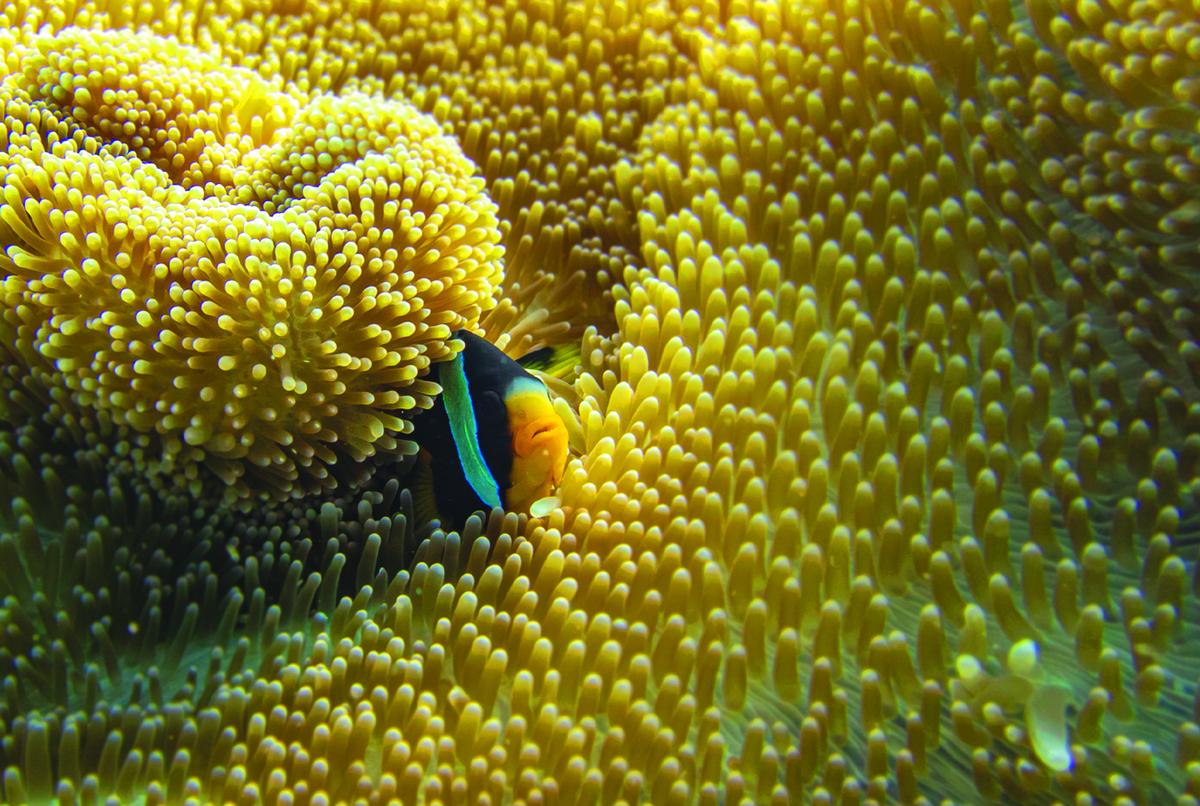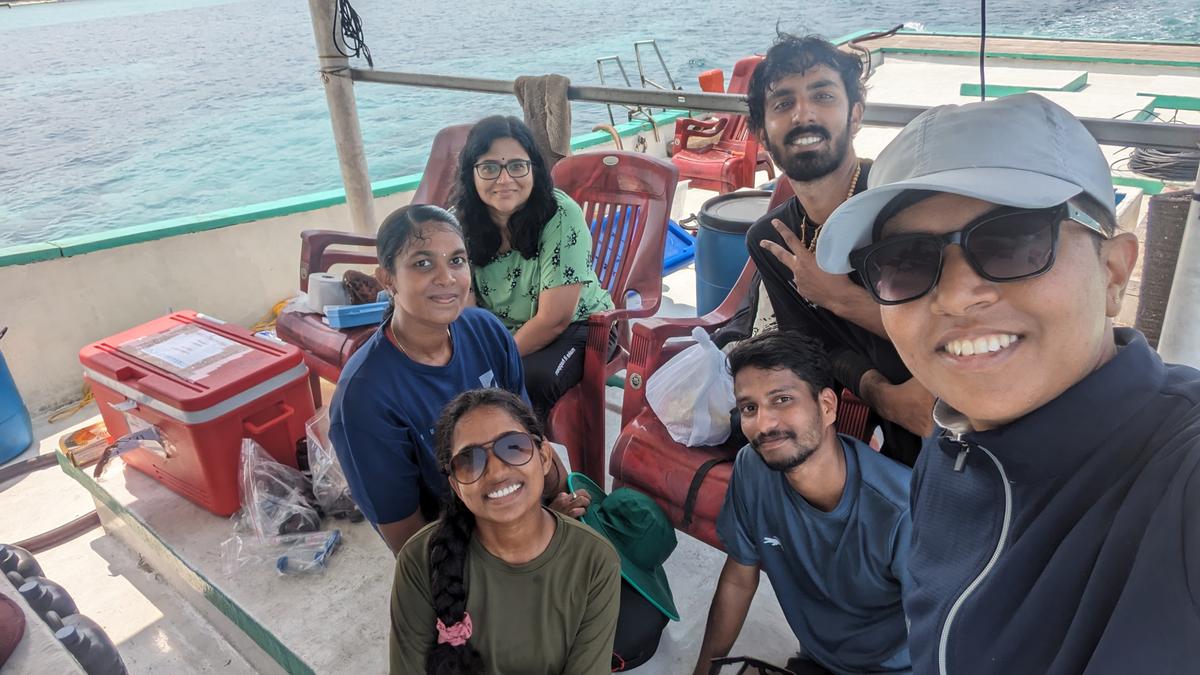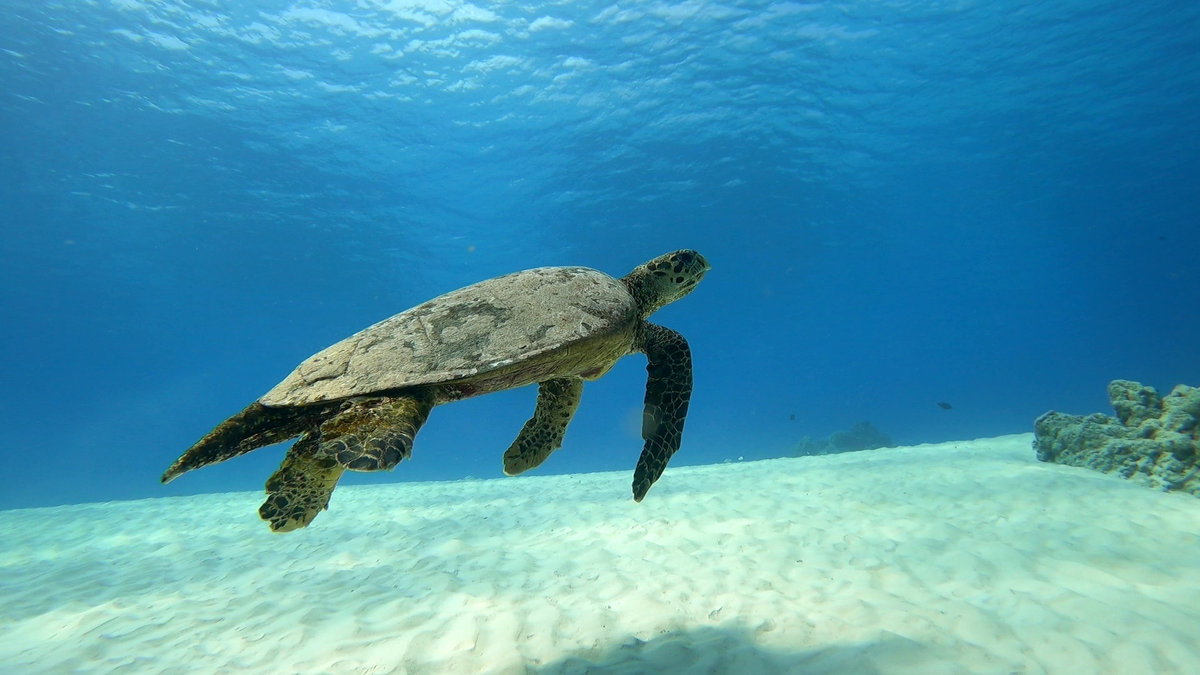A two-month expedition by a team of marine scientists from Kerala University of Fisheries and Ocean Studies found startling evidence pointing to extensive bleaching of coral reefs off the Lakshadweep group of islands. Death of this vital organism will be catastrophic for the marine ecosystem as it will eventually threaten the very existence of the archipelago, reports K.S. Sudhi Krithiga S.S., a young marine researcher, was on a scientific voyage on a fishing vessel in the Lakshadweep waters on a sunny April afternoon to assess the health of the corals of the island group located between 200 and 440 km off her hometown Kochi in Kerala.
Trying to stay steady on the vessel pitching and rolling in the sea, she scanned the horizon only to see the ominous signs of trouble fast approaching in the form of a mass of yellow foam. Gliding on the waves, it closed in quickly.
Initially, it looked like a huge ball of soap foam floating on the water. As the evening approached, it grew in size and spread. It appeared like a yellow blanket thrown over the sea up to the horizon as she returned to the shore. The yellow spread spelt trouble for the famed coral reefs of the archipelago straddling the Arabian Sea and the Lakshadweep Sea.

Sea anemone and clownfish, which enjoy a symbiotic relationship with the corals, could be affected by coral bleaching. A picture taken during a research field visit off the Kavaratti island. | Photo Credit: Special Arrangement
Marine scientists identify the floating yellow foam as zooxanthellae, a microscopic single-celled algae that live within coral polyps, which are being expelled by the corals when under duress.
“From the masks we wore while diving to the divers’ suits, everything was coated with the yellow froth. We had a tough time taking off the suit. On the shore, they looked like black dust spread on the soil,” says Krithiga.

Shoal of Sergeant and Surgeon fish grazing near dead coral boulders in Kavaratti | Photo Credit: Shabaz Khan
“The coral reefs of Lakshadweep are in troubled waters as they are undergoing massive bleaching on an unprecedented scale. It was eight years ago, in 2016, that an en masse bleaching and resultant death and destruction of colonies of coral polyps occurred here,” says Anu Gopinath, Professor and Head in Chemical Oceanography, Department of Aquatic Environment Management of the Kerala University for Fisheries and Ocean Studies, Kochi.
“Acropora coral reefs appear in shades of brown. The fluorescent pink colour on their tips adds to its magical charm. It’s a spectacular sight to behold the vast colonies of corals in the pristine waters in the company of psychedelic-coloured marine fishes that swish and sway through them,” says Anu, who leads a team of young researchers to look at the various aspects of the marine ecosystem associated with the corals.

Researchers of the Kerala University of Fisheries and Ocean Studies on board a fishing vessel during a field trip in the Lakshadweep waters. | Photo Credit: Special Arrangement
Researchers from the Indian National Centre for Ocean Information Services (INCOIS), Telangana, led by R.S. Mahendra, Scientist-F of the Applied Research and Research to Operations and Ocean Modelling Applied Research and Services (OMARS) Division, are partnering with KUFOS in the study.
Corals found at a depth ranging from two to five metres such as Acropora, Pocillopora and Porites were heavily bleached, which might be due to the direct exposure to intense solar radiation and excessive exposure to light. Species such as Favia, Favites, and Montipora living in depths of up to 12 metres were found partially bleached. Acropora was found predominantly bleached in the lagoon areas of the Kavaratti, Agatti, Kadmath and Suheli islands, according to the team members, who surveyed the islands in April and May this year.

Turtle gliding in Lakshadweep waters | Photo Credit: Shabaz Khan
White is the colour of death for corals. On bleaching, they turn white. They slowly break down from the colonies and disintegrate into small pieces only to be washed ashore. One could see huge quantities of dead corals washed ashore on all the five islands surveyed by the team, says Anu.
Arya P. Kumar, a research team member, notes that around 70% of the coral reef area of the islands has undergone bleaching. The total coral area of the Lakshadweep islands is estimated to be approximately 30,000 sq. km.
Humbug damselfishes associated with beautiful Acropora corals | Photo Credit: Abel Varghese
“We have observed that it is the fast-growing and branching corals like Acropora and Pocillopora that are susceptible to bleaching in the Lakshadweep seas. Widespread bleaching was observed off the Kavarathi and Suheli islands, where around 90% of the corals were found on the verge of perishing,” explains Arya, who had undertaken several snorkelling expeditions and deep dives into the ocean depths as part of the studies.
Life beneath the surface
“It’s a very enchanting and colourful life that awaits one in the ocean depths, especially on coral islands. One will first encounter large schools of marine fish species that come in all sorts of colours and shapes as you swish towards the coral reefs. These fishes have a symbiotic relationship with the corals, and they support each other to survive,” explains Abel Varghese, who had taken around 100 such expeditions in the past two years in the coral reefs of the Lakshadweep.
The tube-building polychate worm that lives alongside corals could perish in the event of coral bleaching. A picture taken from Kavaratti. | Photo Credit: Special Arrangement
“Coral reefs in Lakshadweep support a diverse range of marine life, including fish, invertebrates and algae. Reefs act as natural barriers and protect shorelines from erosion and storm surges. The local communities rely on reef-associated fish for sustenance and livelihood,” says Idrees Babu, a native of Kalpeni island and scientist at the Department of Science and Technology of the Union Territory of Lakshadweep.
The reefs, which are a major draw for tourists, also contribute to the local economy. With the onset of monsoon, there has been a slight reduction in water temperatures. The impact of coral bleaching will be felt in a couple of years, fears Babu.
Researchers have identified 178 species of corals in the Lakshadweep waters and the most attractive ones are the Pocillopora, which are popularly known as cauliflower corals. The species gets its name from its resemblance to the vegetable. It stands out with its striking colours. The species can be seen in a wide range of colours, including shades of green, pink, yellowish-brown and pale brown, he explains.
Picture taken from Lakshadweep Islands | Photo Credit: Special Arrangement
“The scientific survey in Suheli was a real challenge as it was an uninhabited island. Though unoccupied, large quantities of plastic and other debris washed ashore could be seen. We spent three nights on the fishing boat, which took us to the islands,” says researcher B. Karthika.
“It was a serene experience sleeping on the deck of the vessel under the starlit sky after a day’s hard work, which included snorkelling. The boat, which was anchored around 300 metres from the shore, softly sways and rolls in the waves. Freshly caught fish from the sea was always part of the meal on board,” recollects Karthika.
“We carried out snorkelling and sample collection from the reefs of Kavarathy, Agathi, Kadamath, Suheli and Androth islands as part of the research programme,” she says.
S.V. Irshad, a native of Kavarathy and a professional diver, also attests to the observations of the marine scientists. Earlier, when the corals were all healthy, they appeared brown. The large expanse of coral reefs has turned white due to bleaching, he says
Vibrant Galaxea coral photographed from Kavaratti island | Photo Credit: Abel Varghese
Irshad, who swoops to the ocean depths to collect water, coral, and sponge samples for the researchers, also guides the researchers in the dives.
“I help researchers collect samples of water, sediments, and zooxanthellae from different ocean depths ranging from 12 to 20 metres. The maximum depth to which one can dive in Kavaratti is 40 metres,” says Irshad. “The present episode of bleaching will go down in scientific records as a severe one when compared to the 2016 event. Large tracts of corals that were found in the pink of their health last year have turned pale,” says Abel, who had monitored the formation continuously during the last two years as part of research programmes.
Anthropogenic activities, says R. Dhinesh, a researcher in the team, are also contributing to the bleaching of corals. Huge quantities of plastic waste can be seen on the shores of the uninhabited island of Suheli. Microplastic was found in water and the sediments. Traces of pesticides were also detected in the samples. However, oil pollution was not found though the islands are located close to the international shipping channel, explains Dhinesh, who looked into the pollution aspects linked to coral bleaching.
T.M Balakrishnan Nair, Scientist-G and Group Director, OMARS, INCOIS, notes that marine heat waves (MHW), denoting periods of high sea surface temperatures, are proving disastrous for the corals. A period of five or more days of higher sea surface temperatures, which are greater than the upper limits of sea surface temperature range during the past 30 years, are deemed to have witnessed an MHW.
“The ocean temperature witnessed a significant rise, and the marine heatwaves persisted for more days, leading to the bleaching process. Zooxanthellae, the microscopic algae that co-exist with many coral species, was not be able to withstand the rising temperature and perished in marine heat waves. This eventually led to the bleaching of the corals,” he explains.
School of blue green damsel fish around variety of coral species | Photo Credit: Abel Varghese
MHWs disrupt the delicate balance of marine ecosystems, triggering widespread consequences. The Indian Ocean is particularly susceptible to such phenomena. The number of MHW days recorded a three-fold increase along the Lakshadweep islands, Kerala, and Karnataka coasts and a two-fold increase along the Andaman and Nicobar coastal regions, he explains.
“However, the impact of marine heatwaves will not be uniform in all the coral species, and some will be highly vulnerable to such temperature variations and perish. Some species will brave the changes and survive even in the face of adverse conditions. We are also looking into the species that survived and those perished in the process. The INCOIS has been offering a coral bleaching alert system and the data on bleaching and post-bleaching events have been gathered as part of the research project,” he explains.
GBR too hit
The bleaching of Lakshadweep corals coincided with the event that took place in the Great Barrier Reefs (GBR) of Australia in April and May 2023, which have been triggered by the MHWs. El Nino, the climatic process which leads to the increase in sea surface temperatures in the central and eastern tropical Pacific, has played the villain in both the cases, points out Anu.
The death of the corals can have a disastrous effect and end up in the collapse of the marine ecosystem. She says it may take a few years for the corals to recover. They will return to life in a while. However, the bleaching events would have taken a toll on the marine ecosystem by then.

